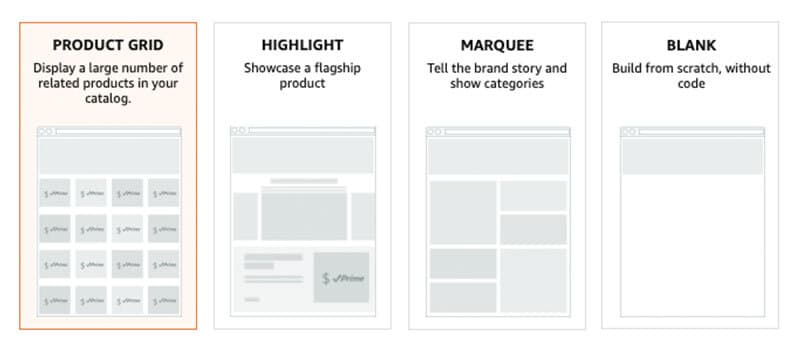How to drive growth with Amazon Brand Stores
As the largest product search engine in the world, Amazon can be an intimidating platform for sellers. Amazon is constantly evolving, with new features and capabilities added on a monthly basis.
Perhaps the most noteworthy addition from recent years is Amazon Brand Stores. In just a few clicks, sellers can drive brand awareness, elevate the user experience, and increase sales velocity.
So, what are you waiting for? Read on to discover how you can drive growth with Amazon Brand Stores.
What is an Amazon Brand Store?
According to Amazon:
“Stores allow you to showcase your brand and products in a multi-page, immersive shopping experience on Amazon.”
Think of them as a mini version of your existing retail website. They are completely free to create and open to all sellers, vendors, and agencies.
The only prerequisite is that you need to be enrolled in Amazon Brand Registry. For this, you’ll need a registered trademark for your brand and the ability to verify yourself as the rights owner or an authorized agent.
Stores themselves are highly flexible in terms of structure and content. You can choose from three pre-existing templates or build them yourself from scratch using content tiles. These multimedia tiles can be photos, videos, text, or product links.

Once your store is built, you’ll need to submit it to Amazon for moderation. This process can take several days and the most common reasons for rejection are:
- Incorrect spelling, spacing, or grammar
- Use of prohibited words and phrases
- Unverified claims such as, “the world’s best…”
- Linking to your website or other channels
- Confusing UX design
Make sure to allow yourself plenty of time to get your store approved.
Benefits of having an Amazon Brand Store for your business.
Now that you understand the basics, let’s move on to why your Amazon business needs a brand store.
#1 – Heightened Branding Capabilities
First and foremost, stores give you an unrivalled opportunity to control your branding within the Amazon platform. Here, you can showcase your entire range of products, convey your USPs, and tell your story.
That’s not all.
The best part is that all of this can be achieved without interference from competitors. Although brand stores can be promoted using Amazon Ads, stores themselves are entirely free from advertisements. This makes them an extremely valuable brand asset.
Using the customizable content tiles, you can establish a consistent brand identity across all platforms. Or why not take it one step further and replicate the layout of your existing eCommerce website.
#2 – Enhanced Product Visibility
Another way in which stores help to drive product visibility is by acting as landing pages. There are two ways this can occur: internally and externally.
Firstly, internal Amazon traffic can be directed to stores through Sponsored Brand campaigns. These ads predominantly appear at the top of Amazon Search Engine Results Pages (SERPs). Interestingly, Amazon argues that Sponsored Brand campaigns that drive consumers to Stores have a 22% better Return on Ad Spend (ROAS) than those linking to product pages.
Alternatively, traffic can be driven to stores from external third-party sites such as Google, Facebook, Instagram., The Store builder also allows you to create trackable source tags. So this external traffic can also be organic or paid.

A Sponsored Brand Store Spotlight campaign. Clicking either of these three images will take you to the corresponding Brand Store page.
#3 – Increased Search Engine Discoverability
In a similar vein, brand stores are also included in Amazon’s sitemap and therefore indexed by Google. Put simply, this means they’re crawled by Google Bots and stored in Google’s index, making them discoverable in search results.
What’s more, as the world’s largest online retailer, the Amazon platform naturally has high domain authority. So brand stores often appear pretty high in search results.
#4 – Plan Ahead with Scheduling and Version Control
Two of the most recent additions to the brand store repertoire are scheduling and version control.
Prior to these updates, all store edits were permanent. So if you made a minor error, there was no easy way to revert back to the previous version of your store. You’d have to manually reverse the changes yourself.
Similarly, if you wanted to update your store for the holidays or upcoming promotion, there was no way to do this ahead of time. Instead, you’d have to complete the changes as and when you wanted them. But again, this isn’t ideal because Amazon’s store review process can take up to 48 hours.
Thankfully, both of these scenarios have been improved.
You can now schedule your store to be published at specific dates and times, which allows sellers to plan ahead and prepare for holidays, seasonal changes, and new releases. Moreover, once a holiday or specific period has elapsed, you can simply revert your store to a previous version.
Brand store best practices.
- Keep your store stocked – This is particularly important if you’re operating in a fast-paced industry such as fast fashion. Shoppers will quickly become frustrated if your store is filled with items that are no longer available.
- Remove out of stock ASINs – For product grids, an easy way to do this is by selecting the ‘automatically hide out of stock ASINs’ button.
- Make sure your byline is linked – When you first create a brand store, the subheading under the product title on your detail page should change from ‘Brand: ABC’ to ‘Visit the ABC store’. However, Amazon can be glitchy so if this doesn’t happen contact Seller Support.
- Use high-quality imagery – Visually appealing stores help to establish and build trust.
Amazon Brand Stores and you.
If you want to dominate your niche on Amazon, brand stores are essential. If you are ready to take your Amazon business to the next level, contact Fluid Commerce today.